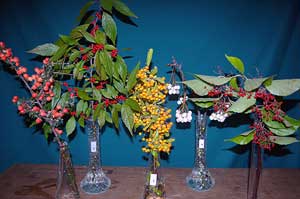October Color Appears at the Washington Park Arboretum

1) Cotoneaster conspicuus
- This showy member of the rose family is native to Tibet.
- Like most other specimens of the genus Cotoneaster, C. conspicuus has an equally stunning, early summer display of white flowers.
- C. conspicuus can be viewed along the north border of the Graham Visitor Center parking lot.
2) Ilex verticillata ‘Winter Red’ Black Alder, Winterberry
- Native to eastern North America, winterberry is an important winter food source for wildlife including raccoon, red squirrel, wood duck and ruffed grouse.
- The cultivar ‘Winter Red’ produces intensely red berries that can last until spring.
- I.v. ‘Winter Red’ can be seen just to the north of the Overlook Pond on Azalea Way.
3) Pyracantha rogersiana ‘Flava’ Firethorn
- Many firethorns are grown for their showy berries in fall, which can range from lemon-yellow to scarlet.
- Pyracantha has traditionally been used as a decorative ornamental, as a pollen source for bees and for home security due to their vicious thorns.
- Several firethorn species and cultivars can be seen along Arboretum Drive just south of the Graham Visitor Center.
4) Sorbus cashmiriana Kashmir Rowan
- Native to the western Himalayas, this rowan bears corymbs of white flowers in late spring followed by pink-tinged white pommes.
- Our Sorbus Collection is located on the east side of Arboretum Drive between Crabapple Meadow and our giant sequoia grove.
5) Viburnum sp.
- This Viburnum, which was collected in China, has yet to be identified to a species.
- The tiny, brilliant red berries are unusual to the genus.
- This Viburnum is located along Azalea Way near our Fraxinus (True Ash) Collection.